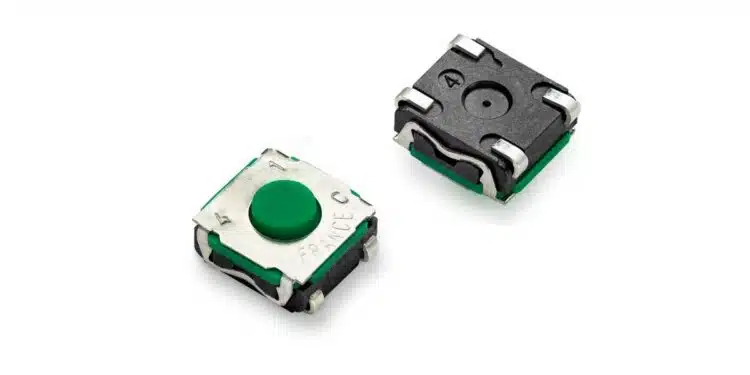Littelfuse releases KSC2 DCT tactile switches with compact 3.5mm actuator enhance precision and speed in space-constrained applications.
Dual Circuit Technology, a shorter actuator, and Electrical Height precision empower designers to create reliable and high-performance devices for consumer electronics, medical, industrial, and automotive markets.
Littelfuse, Inc., an industrial technology manufacturing company empowering a sustainable, connected, and safer world, announces theC&K Switches KSC2 Dual Circuit Technology (DCT) Series Tactile Switches. The latest addition to its innovative tactile switch series offers a 3.5 mm actuator height, lower than the KSC4 DCT with its 5.2 mm actuator height. Combined with single pole double throw (SPDT) functionality and the Electrical Height specification, the KSC2 DCT delivers unmatched functionality in a compact, space-saving design. (View the video.)
The KSC2 DCT offers designers increased flexibility for creating slim, precise, and reliable products. Its shorter actuator travel results in faster response times, which is critical for applications requiring high speed and accurate input. Combined with its robust IP67-rated sealing and SPDT functionality, the KSC2 DCT is ideal for demanding environments where compactness, reliability, and advanced functionality are paramount.
The new 3.5 mm actuator height sets the KSC2 DCT apart by offering a combination of space-saving design, faster response times, and improved integration. Its compact profile is ideal for slim and compact devices where every millimeter matters, while the shorter travel distance enables quicker signal registration, enhancing device performance. Additionally, the reduced height allows the switch to fit seamlessly into tighter spaces, providing greater design flexibility for engineers.
“By offering a lower actuator height, we’re enabling designers to achieve greater precision and faster response in smaller form factors,” said Jeremy Hebras, Vice President of Digital & Technical Developments, Electronics Business Unit at Littelfuse. “This addition reflects our commitment to advancing functionality while meeting the space-saving demands of today’s applications.”
The KSC2 DCT incorporates Dual Circuit Technology (DCT), meaning it has a single-pole double-throw (SPDT) configuration, which generates two independent output signals within a single switch. This feature enhances reliability and versatility, allowing:
- Active Failure Detection: Enables systems to verify logic before execution, enhancing safety (e.g., preventing unintended door openings).
- Complex Control Schemes: Provides flexibility to define logic-based actions for advanced device functionality.
- Simplified Circuit Design: Reduces the number of switches and wiring, streamlining development and lowering costs.
The KSC2 DCT and KSC4 DCT tactile switches now include the Electrical Height specification, which ensures a precise switching position relative to the PCB. This enhancement reduces cumulative tolerance errors and simplifies integration into designs. The specification eliminates variability by offering a standardized accuracy of ±0.15 mm or ±0.2 mm, providing consistent and reliable functionality across applications. Additionally, it streamlines design processes, accelerating integration and reducing development time for engineers.
Applications and Markets
The KSC2 DCT is designed for a variety of applications, including:
- High-End Consumer: Power tools, lawnmowers, snow blowers.
- Medical: Electrosurgical instruments.
- Industrial: Elevators, smoke/fire alarm systems, automation equipment.
- Transportation: Automotive door handles, EV charging stations.
Why Choose the KSC2 DCT?
The KSC2 DCT’s 6.2 x 6.2 mm footprint, compact 3.5 mm actuator height, and SPDT functionality provide designers with a reliable, versatile solution for modern device challenges. By incorporating multiple electrical functions into a single, space-efficient switch, the KSC2 DCT sets a new standard for tactile switch performance.
“After our first-to-the-world introduction of the DCT circuitry in the KSC4 DCT Tactile Switch Series, we are now expanding this offering to an even smaller form factor, supported by our continuously demonstrated micro-mechanism expertise,” said Jeremy Hebras. “Coupled with Electrical Height functionality, this is recommended to our customers designing for tighter spaces to also benefit from this unique solution, allowing them to enrich their own device with more electrical functions, in one small and single SMT package.”
For additional information, see the following:
- Tactile Switch Electrical Height Versus Electrical Travel Application Note
- KSC DCT Tactile Switch Series Application Brief
Availability
The KSC2 DCT Tactile Switches are available in tape and reel format in quantities of 1,400. Sample requests are accepted through authorized Littelfuse distributors worldwide.































